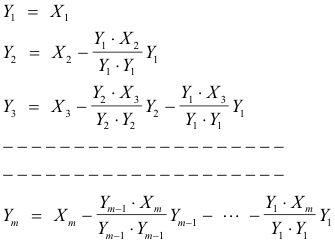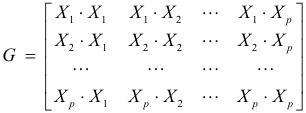
Website owner: James Miller
Vectors over real n-space, Inner products, Orthogonal vectors and spaces, Triangle Inequality, Schwarz Inequality, Gram-Schmidt orthogonalization process, Gramian Matrix
We will, on this page, present results for vectors over real n-space, Vn(R). Vector elements and scalars are real numbers from the field of real numbers, R.
Inner (or scalar) product of two real n-vectors. Let

and

be two vectors whose elements are real numbers. Then their inner product is given by
![]()
The inner product is called the dot product in vector analysis.
Note that the concept of the inner product of vectors of n-space represents a generalization of the concept of the dot product of vectors in three-dimensional space. Much in the theory of n-space is a generalization of concepts of ordinary three-dimensional space.
Properties of inner products. Let X, Y and Z be real n-vectors and c be a real number. Then the following laws hold:
1. X•Y = Y•X Commutative Law
2. (cX)•Y = c(X•Y)
3. X•(Y + Z) = X•Y + X•Z Distributive Law
Orthogonal vectors. Two vectors in n-space are said to be orthogonal if their inner product is zero.
The concept of orthogonality of vectors in n-dimensional space represents a generalization of the concept of perpendicularity of vectors in two and three-dimensional space. Vectors in ordinary two and three-dimensional space are perpendicular if and only if their inner products (or dot products) are zero.
Length of a real vector. The length of a real n-vector

is denoted by ||X|| and defined as
![]()
![]()
The concept of the length of vectors in n-space represents a generalization of the concept of length in two and three-dimensional space. In the case of two and three-dimension space it corresponds to the usual concept of length.
A vector X whose length is ||X|| = 1 is called a unit vector. The elementary vectors Ei are examples of unit vectors.
Theorem. For two real n-vectors X and Y:
![]()
The Triangle Inequality. For two real n-vectors X and Y
![]()
The Schwarz Inequality. For two real n-vectors X and Y
![]()
Orthogonal vectors and spaces. The concept of n mutually orthogonal vectors of
n-space corresponds to the concept of a set of three mutually perpendicular vectors in 3-space.
Theorems
1] Any set of m mutually orthogonal non-zero vectors of n-space is a linearly independent set and spans an m-dimensional subspace of n-space.
Example. Let n = 3 and m = 2 in the above theorem. It then says that any set of 2 mutually orthogonal non-zero vectors of 3-space is a linearly independent set and spans a 2-dimensional subspace of 3-space (i.e. a plane).
A vector is said to be orthogonal to a vector space if it is orthogonal to every vector of the space. (For an intuitive example of this consider a plane passing through the origin in 3-space and a vector that is perpendicular to it. The vector is orthogonal to the two-dimension subspace of 3-space represented by the plane – and orthogonal to every vector in it.).
2] If a vector is orthogonal to each of the vectors X1, X2, ... ,Xm of n-space it is orthogonal to the space spanned by them.
3] Let Vnh(R) be a h-dimensional subspace of a k-dimensional subspace Vnk(R) of real n-space Vn(R) where h < k. Then there exists at least one vector X of Vnk(R) which is orthogonal to Vnh(R) .
Example. Pass a plane through the origin of a Cartesian system in three dimensional space and label it K. Let L be a line in plane K that passes through the origin. Let Vnh(R) be line L and Vnk(R) be plane K and Vn(R) be 3-space. Then the theorem says that plane K must contain at least one line perpendicular to line L.
4] Every m-dimensional vector space contains exactly m mutually orthogonal vectors.
5] Two vector spaces are said to be orthogonal if every vector of one is orthogonal to every vector of the other space.
Example. A plane passing through the origin in 3-space and a line that is perpendicular to it.
6] The set of all vectors orthogonal to every vector of a given k-dimensional vector subspace Vnk(R) of n-space is a unique (n - k)-dimensional subspace Vnn-k(R) .
Unit vectors in n-space. Normalization of vectors. We may associate with any vector X ≠ 0 a unique unit vector U obtained by dividing the components of X by ||X|| . This operation is called normalization.
Example. To normalize the vector

divide each component by
![]()
and obtain the unit vector
 .
.
Orthogonal bases. A basis of a vector space (or subspace) that consists of mutually orthogonal vectors is called an orthogonal basis of the space.
Orthonormal bases. If the mutually orthogonal vectors of an orthogonal basis of a space are also unit vectors the basis is called a normal orthogonal or orthonormal basis.
The Gram-Schmidt orthogonalization process. Suppose X1, X2, .... ,Xm constitute a basis of some vector space. The Gram-Schmidt orthogonalization process is a procedure for generating from these m vectors an orthogonal basis for the space. The process involves computing a sequence Y1, Y2, .... ,Ym inductively as follows:

or, stated more succinctly,
![]()

The vectors Y1, Y2, .... ,Ym given by the above algorithm are mutually orthogonal but not orthonormal. To obtain an orthonormal sequence replace each Yi by
![]()
The Gramian Matrix. Let X1, X2, .... ,Xp be a set of real n-vectors. The Gramian matrix is defined as

where Xi∙Xj is the inner product of Xi and Xj .
A set of vectors X1, X2, .... ,Xp are mutually orthogonal if and only if their Gramian matrix is diagonal.
For a set of real n-vectors X1, X2, .... ,Xp , the determinant of the Gramian matrix |G| has a value
|G|
![]() 0. The set of vectors are linearly dependent if and only if |G| = 0.
0. The set of vectors are linearly dependent if and only if |G| = 0.
Orthogonal matrices. An orthogonal matrix is defined as a square matrix that is equal to the inverse of its transpose. This stated condition
![]()
is equivalent to the condition
![]()
or
![]()
Thus we see that an orthogonal matrix is one whose inverse is equal to its transpose.
Theorems
1] The column vectors of an orthogonal matrix are mutually orthogonal unit vectors. The same is true for its row vectors – they also are mutually orthogonal unit vectors.
2] If the real n-square matrix A is orthogonal, its column vectors (or row vectors) are an orthonormal basis of Vn(R), and conversely.
3] The inverse and transpose of an orthogonal matrix are orthogonal.
4] The product of two or more orthogonal matrices is orthogonal.
5] The determinant of an orthogonal matrix has a value of +1 or -1.
Orthogonal transformations. A linear transformation Y = AX is called orthogonal if its matrix A is orthogonal.
Theorems
1] A linear transformation Y = AX preserves lengths if and only if it preserves inner products.
Let a linear transformation Y = AX carry n-vectors X1 into X2 into Y1 and Y2, respectively. Then the linear transformation preserves lengths if and only if X1 • X2 = Y1 •Y2 .
2] A linear transformation preserves lengths if and only if it is orthogonal.
In three dimensional space an orthogonal transformation corresponds to a rotation of the coordinate system. In n-dimensional space an orthogonal transformation corresponds to the n-dimensional equivalent of a coordinate system rotation.
3] If the linear transformation Y= AX is a transformation of coordinates from the E-basis to another, the Z-basis, then the Z-basis is orthogonal if and only if A is orthogonal.
References.
Ayres. Matrices (Schaum).
Jesus Christ and His Teachings
Way of enlightenment, wisdom, and understanding
America, a corrupt, depraved, shameless country
On integrity and the lack of it
The test of a person's Christianity is what he is
Ninety five percent of the problems that most people have come from personal foolishness
Liberalism, socialism and the modern welfare state
The desire to harm, a motivation for conduct
On Self-sufficient Country Living, Homesteading
Topically Arranged Proverbs, Precepts, Quotations. Common Sayings. Poor Richard's Almanac.
Theory on the Formation of Character
People are like radio tuners --- they pick out and listen to one wavelength and ignore the rest
Cause of Character Traits --- According to Aristotle
We are what we eat --- living under the discipline of a diet
Avoiding problems and trouble in life
Role of habit in formation of character
Personal attributes of the true Christian
What determines a person's character?
Love of God and love of virtue are closely united
Intellectual disparities among people and the power in good habits
Tools of Satan. Tactics and Tricks used by the Devil.
The Natural Way -- The Unnatural Way
Wisdom, Reason and Virtue are closely related
Knowledge is one thing, wisdom is another
My views on Christianity in America
The most important thing in life is understanding
We are all examples --- for good or for bad
Television --- spiritual poison
The Prime Mover that decides "What We Are"
Where do our outlooks, attitudes and values come from?
Sin is serious business. The punishment for it is real. Hell is real.
Self-imposed discipline and regimentation
Achieving happiness in life --- a matter of the right strategies
Self-control, self-restraint, self-discipline basic to so much in life